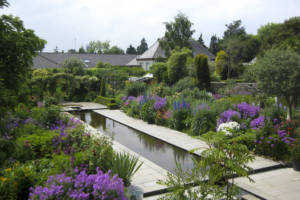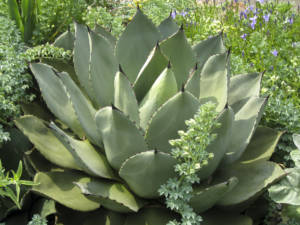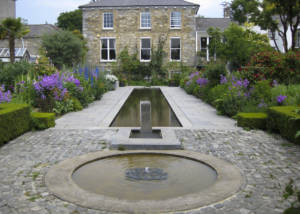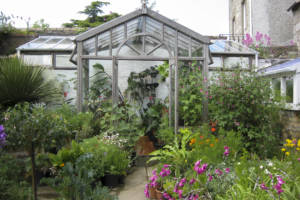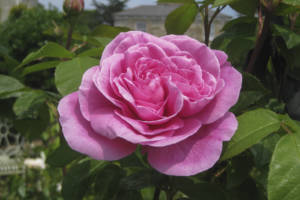
Helen Dillon’s Irish Garden is a Dublin Delight
On a gorgeous day in June, just a 30-minute walk from the busy city center of Dublin, I encountered the most lovely, small garden surrounded by aging stone walls. One would never guess it was there by walking up to the front of the 1830’s style house, which sits on less than an acre off a suburban road on a narrow, upscale, residential street. The location may be inconspicuous, but The Dillon Garden‘s fame is international, as Helen Dillon is one of Ireland’s most time-honored gardening experts.
We rang the bell and entered a home filled with antique furniture and objects collected by Dillon’s husband, Val, an antique dealer. Suddenly, straight ahead from the entrance, a breathtaking view of the garden emerged from huge windows overlooking the back of the house.
When we recently met, Dillon described her garden as “the unique result of 44-years’ struggle between thinking with the reticence of a garden designer about plants, versus the never ending joy of buying new plants.”
The Dillons bought their house in 1972 and inherited “roses, apple trees, a wobbly greenhouse, henhouses, a large bed of bearded iris, a vegetable patch, and a pile of stones in middle of the lawn.” But it was a great space for Val’s antiques, and Helen took up the challenge of “imposing order” with a formal garden design that would still allow creative success. Today, her garden is considered one of the best gardens in Ireland, and has won Dillon several international awards.

Dillon’s garden is located in a region of Ireland that gets less than 30 inches of annual rainfall, much like USDA Zone 8 (similar to Seattle). But it is generally pretty humid and the sun hangs low in the sky, with a less intense light. In the summer, there are evenings in which it is light outside until 10 PM.
By 1976, Dillon had started keeping detailed records of what plants were added and where. They built a Victorian style greenhouse that year, which encouraged Dillon to start organizing plantings by preferred habitat. Her method: “the plant always comes first, next comes color, and finally repetition of groups.”
Replacing the Lawns
In one of her books, Down to Earth with Helen Dillon, Dillon traces the evolution of her garden and “the things she shouldn’t have done,” noting that with inherited gardens people are often afraid to move things, believing that they have always been there.
The biggest upheaval in her garden came with replacing the main lawn area with a canal set in Irish limestone. “It was inspired by a holiday near the Alhambra in Spain,” Dillon explains, “and was built by an excellent local builder.”
The round pool at the far end of the canal was already built when the Dillons first arrived. “It was so difficult to make it level that eventually we surrounded it with a circle of wet cement and got a long plank and pulled it over the whole thing.”
The canal and pool create a peaceful and serene space bordered by sweeps of purple allium and hesperis. By July, the borders will morph into summer-blooming dahlias, cannas, brugmansias (aka angel’s trumpets), and other tender plants in the remaining spaces.
Dillon also dug up a second oval lawn area to make a gravel garden and pathways. She warns: “Gravel has an instinct to be always on the move; it’s been shifting around the planet since the last Ice Age and it doesn’t intend to stop.”
“To examine plants closely, Dillon believes that you need really good pathways.”
For this reason, when she replaced that area with gravel in 2003, Dillon made certain the soil was clean of perennial weeds. She leveled the area, firmed it, and raked it again before spreading pea gravel. Once you’ve done it right, she explains, the gravel areas require very little work.
Thinking About Color
Dillon’s favorite plantings for summer and fall require some advance work.
“I like to sow a batch of tall cosmos in late May so as to have fresh plants for early autumn,” she told me. “The tallest angel’s fishing rods (dierama) are quite wonderful in August. I also like two ordinary, excellent plants – Aster x frikartii ‘Mönch’, which includes light pink, mid-pink, and dark-purple blooms, and Helianthus ‘Lemon Queen’– a bright sunflower.”
Dillon’s roses include the fabulous, fragrant Rosa ‘Gertrude Jekyll’, a fairly small-size shrub rose with very large pink blooms that provide a good screen for a sitting area at the back of the garden. Dillon says that her roses are fed again after flowering in June and July, prompting “a great show in early autumn.”
The small gravel garden in the rear features whimsical boxwoods turned into “box bowls.” As you wander through various paths, there’s a sundial, or a statue, or an amazing variety of ferns in a shady spot. To examine plants closely, Dillon believes that you need really good pathways.
Creating Peace with Color
Dillon gets transfixed by certain colors and was known in the past for her blue and red borders, which have more recently morphed into a subtle mix of colors stretching along each side of the canals.
Mauves, lilacs, purples, and violets actually have found a home in what once was mostly a blue border, along with towering white, self-seeded foxgloves. But because of the repetition of color running through the whole bed, the overall effect is utterly magical.
When asked what she’d most like visitors to take away from their experience of her garden, Dillon replied: “Even if they don’t know the name of a single plant, I’d like them to enjoy the peace of color in the garden.”
Last Chance to Visit
The Dillon garden will be closed permanently later this year, because Helen and Val have recently sold the entire estate. They plan to move to a home with a smaller garden to maintain as they are aging– a subject Helen writes about eloquently. “For later life,” she advises, “you should plan your garden so that gardening is of the most tranquil kind, with masses of time for sitting and thinking how lovely everything is, without being harassed by urgent gardening chores.” This is elegant wisdom from a life-long gardener, but it’s pretty good advice for any age.
It is too early to say what the new owners will do with the Dillon’s property– but for the rest of the summer and until the end of September, the garden will be open to visitors daily from 2- 6 PM. Helen Dillon’s Dublin garden is absolutely worth the trip.


























